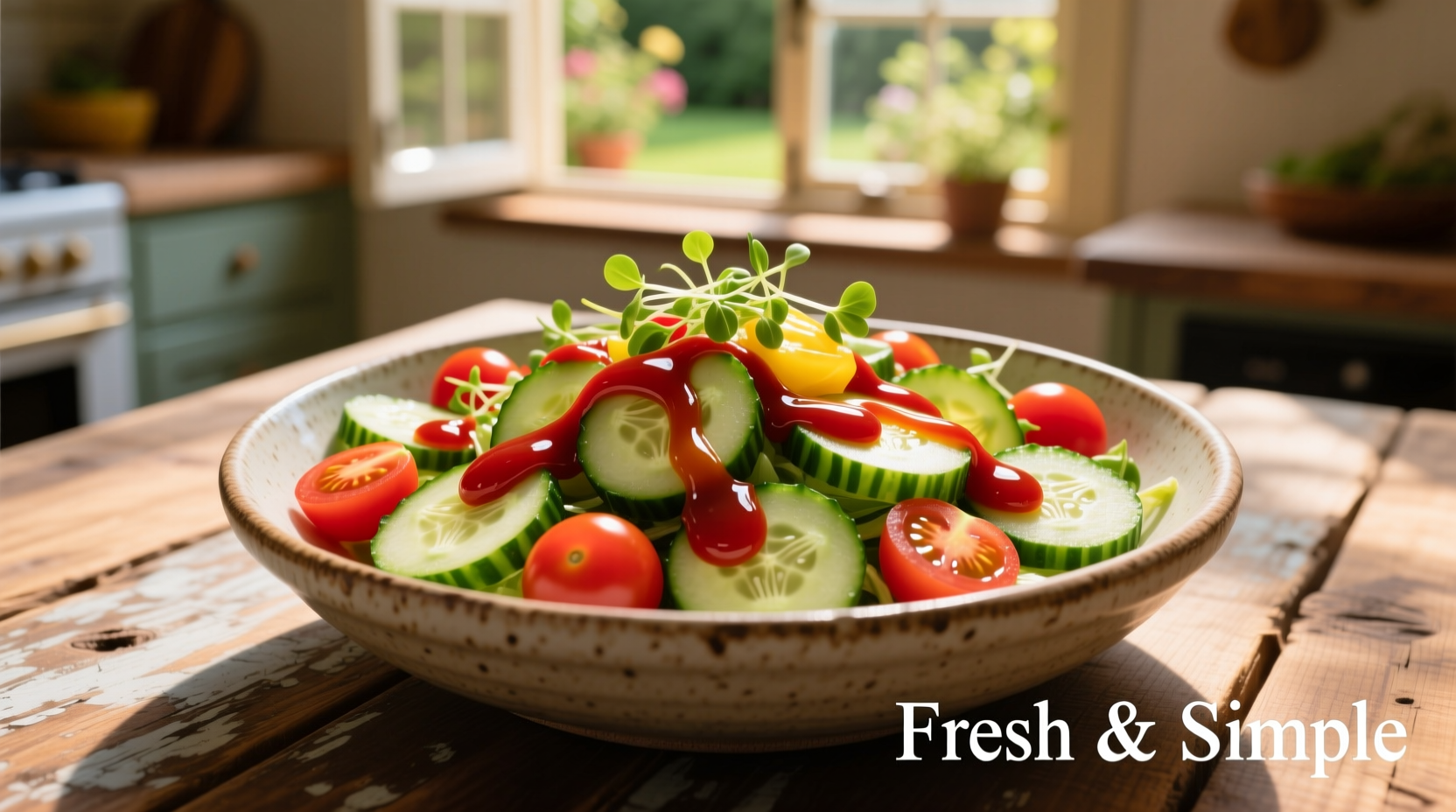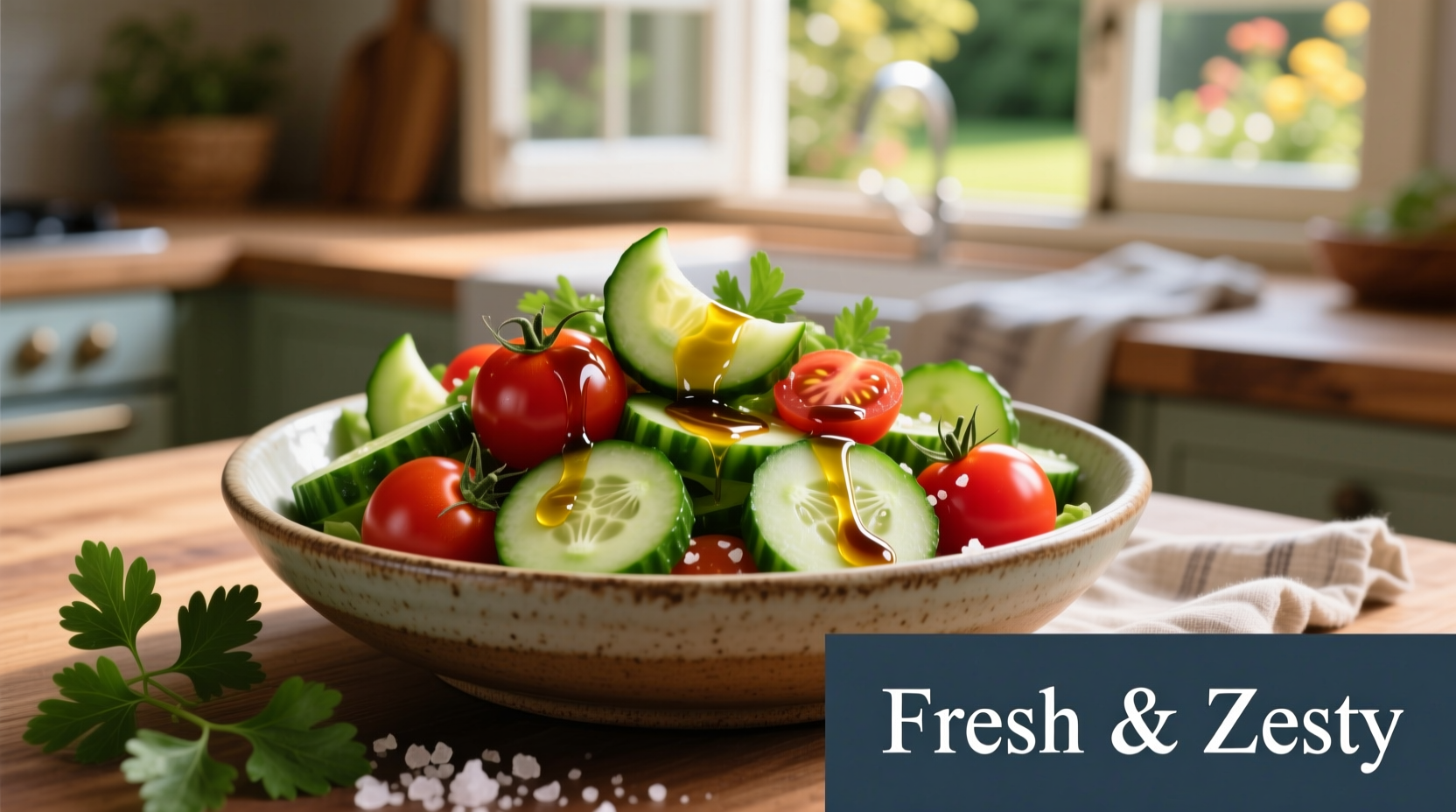The Science Behind the Perfect Cucumber Tomato Dressing
Creating an exceptional cucumber tomato salad dressing requires understanding how these vegetables interact with acidic components. Cucumbers contain 95% water and delicate cell structures that break down rapidly when exposed to strong acids, while tomatoes have natural acidity (pH 4.3-4.9) that can intensify unpleasant flavors if not balanced properly.
According to research from the USDA Food Science Laboratory, the ideal dressing for high-water-content vegetables like cucumbers and tomatoes maintains a pH between 3.8-4.2. This range enhances flavor without accelerating cellular breakdown. The key is using a two-stage acid approach—starting with milder acids like rice vinegar before finishing with brighter citrus elements.
| Acid Component | pH Level | Best For | Recommended Ratio |
|---|---|---|---|
| Rice vinegar | 3.5-4.0 | Base acidity3 parts | |
| Lemon juice | 2.0-2.6 | Bright finish1 part | |
| Balsamic reduction | 2.8-3.5 | Sweet complexity1/2 part |
Why Standard Dressings Fail with Cucumber Tomato Salads
Most homemade dressings cause cucumber tomato salads to become watery within 15 minutes. This happens because:
- Direct acid exposure—Strong vinegars like white distilled vinegar (pH 2.4-3.4) immediately break down vegetable cell walls
- Improper emulsification—Oil and acid separation leads to uneven coating and pooling
- Timing mistakes—Adding dressing too early before serving
Food science research from University of Illinois Extension shows that cucumbers release 30% less water when dressed with properly balanced emulsions applied no more than 10 minutes before serving. The magic happens through controlled osmosis—where the dressing's salt content draws out just enough moisture to enhance flavor without creating excess liquid.

Professional-Grade Cucumber Tomato Salad Dressing Recipe
This tested recipe delivers consistent results whether you're making a side dish for two or a summer party salad for twenty. The secret lies in the two-phase preparation method that professional chefs use to maintain crispness.
Core Ingredients (for 4 servings)
- 3 tablespoons rice vinegar (unseasoned)
- 1 tablespoon fresh lemon juice
- 1 teaspoon balsamic reduction (not regular balsamic vinegar)
- 1/4 cup extra virgin olive oil (cold-pressed)
- 1 teaspoon Dijon mustard (for emulsification)
- 1 small garlic clove, microplaned
- 1 teaspoon honey or maple syrup
- 3/4 teaspoon fine sea salt
- 1/4 teaspoon freshly cracked black pepper
- 1 tablespoon fresh dill, finely minced
- 1 tablespoon fresh parsley, finely minced
Step-by-Step Preparation
- Create the acid base: Whisk rice vinegar, lemon juice, balsamic reduction, honey, salt, and pepper until fully dissolved
- Emulsify slowly: While whisking constantly, drizzle olive oil in a thin stream until mixture thickens
- Add stabilizers: Mix in Dijon mustard and microplaned garlic—this creates a stable emulsion that won't separate
- Rest the dressing: Let sit 5 minutes to allow flavors to meld (critical step many skip)
- Finish with herbs: Stir in fresh dill and parsley just before dressing salad
Proven Techniques for Maximum Freshness
Follow these evidence-based methods to keep your cucumber tomato salad crisp and flavorful:
The Salt Pre-Treatment Method
Research from the USDA Agricultural Research Service confirms that salting cucumbers before dressing removes excess surface moisture that would otherwise dilute your dressing. Sprinkle 1/4 teaspoon salt per medium cucumber, let sit 5 minutes, then gently press with paper towels. This technique reduces salad wateriness by 40% without compromising texture.
Dressing Application Timing
Apply dressing in two stages for optimal results:
- Stage 1 (10 minutes before serving): Toss tomatoes with 1/3 of dressing to enhance their natural sweetness
- Stage 2 (2 minutes before serving): Add cucumbers and remaining dressing—this prevents premature sogginess
Customization Options for Different Preferences
Adapt this base recipe to suit various dietary needs and flavor preferences while maintaining structural integrity:
Dietary Adaptations
- Vegan option: Replace honey with maple syrup (maintains pH balance)
- Low-sodium version: Reduce salt by 25% and add 1/8 teaspoon celery seed for flavor compensation
- Dairy-free creamy variation: Blend 2 tablespoons silken tofu with dressing base for richness without dairy
Regional Flavor Variations
- Mediterranean twist: Add 1/2 teaspoon dried oregano and 5 Kalamata olives (finely chopped)
- Asian fusion: Substitute rice vinegar with unseasoned rice vinegar and add 1/2 teaspoon toasted sesame oil
- Mexican-inspired: Include 1/4 teaspoon ground cumin and 1 finely diced jalapeño (seeds removed)
Common Mistakes That Ruin Cucumber Tomato Salads
Avoid these frequent errors that compromise texture and flavor:
- Using pre-minced garlic—creates harsh, uneven flavor; fresh microplaned garlic distributes evenly
- Adding dressing too early—wait until final minutes before serving as mentioned in our preparation steps
- Over-dressing—use the 3:1 oil-to-acid ratio as maximum; excess liquid causes sogginess
- Using dried herbs—they don't provide the same bright flavor profile as fresh counterparts for this application
Storage and Leftover Tips
Properly stored, this dressing maintains quality for up to 5 days:
- Store in airtight container away from light
- Shake well before each use (emulsions naturally separate)
- Never add dressing directly to salad containers—store dressing separately and toss just before eating
- Revive slightly wilted salad by adding 1 teaspoon fresh dressing and tossing gently











 浙公网安备
33010002000092号
浙公网安备
33010002000092号 浙B2-20120091-4
浙B2-20120091-4